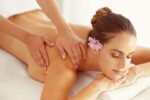Along with other therapies, massage therapy may be helpful for people with TMJ syndrome and can ease their pain. Due to the pain and stiffness of the jaw, face, and neck, the TMJ rests on the temporomandibular joint that attaches your jaw to your skull. Along with other therapies by massaging the muscles around the temporomandibular joint, patients with TMJ may be able to significantly reduce their pain and reduce the symptoms of TMJ.
What is TMJ Syndrome
There are many causes of TMJ syndrome. Most people can control pain and discomfort by taking care of themselves at home. Long-term complications of the temporomandibular joint syndrome include chronic facial pain or chronic headache. In severe conditions, long-term treatment may be necessary when the pain is chronic or has other inflammatory disorders.
This is why TMJ disorders can be so debilitating and problematic. Every time you open your mouth it is used to eat, drink or talk to the jaw. Chronic TMJ pain can make it difficult to have a casual conversation or chew solid food, and these conditions can have a major impact on your quality of life. Your health suffers when it comes to eating a balanced diet.
The cause of a TMJ disorder varies from person to person. Some people have arthritis or factors that may have been linked to the previous injury. For others, the symptoms are related to stress.
What are the Causes of TMJ Syndrome
Experts have yet to find out the exact causes of the syndrome. Many factors can contribute to the stiffness of this muscle and its poor performance. Causes have also been studied, including:
- Problems in the jaw and teeth due to injury
- Teeth Abrasion
- Poor body position
- Stress or anxiety
- Chronic pain and inflammation in the jaw area
- Orthodontic brackets
- Chewing too much gum
Prevent TMJ Syndrome
Symptoms of TMJ syndrome are disproportionately linked to stress and lifestyle. Prevention of Symptoms of Temporomandibular Joint Syndrome can often be done at home using self-care, some of which include:
- Eat soft foods
- Avoid eating too much gum
- Maintain the right position
- Practice stress reduction and relaxation techniques
- The use of plastic toothbrushes recommended by jaw care professionals
- Use appropriate safety equipment to prevent jaw fracture and move it during exercise, work or exercise.
Use massage for TMJ
While massage may be useful for some people with TMJ, no massage therapy can be recommended as a primary treatment for the disease but can be used as an adjunct therapy. Massage can increase the speed of recovery and relieve pain.
Strategies such as applying hot and cold packages to the affected area may also provide TMJ relief, while alternative therapies such as acupuncture and biofeedback are indicated as natural TMJ therapies.
For the treatment of TMJ, it is important to consider triggers such as grinding teeth, stress and behavioral factors (such as chewing gum too much).
Talk to your doctor if you have symptoms of TMJ (such as jaw stiffness and pain). In addition to prescribing TMJ treatments, massage can be used to help heal the disease.

The Science Behind TMJ and Massage
So far, few studies have investigated the efficacy of massage in the treatment of TMJ. However, existing research has yielded positive findings.
For example, in a 2003 report, researchers examined 192 TMJ patients on the use of complementary and alternative therapies in the treatment of TMJ. Of all the treatments reported, massage is considered to be one of the most useful methods. In a 2007 study of 126 patients with TMJ, however, participants described massage as one of the most effective self-care strategies to relieve pain and control disease and improve recovery.
Other studies of the benefits of massage have tested the effects of massage on TMJ pain. For example, a 2009 study of 15 patients found that massaging the lateral pterygoid muscle (the muscle involved in jaw opening) relieved patients’ pain, reduced joint clicks, and increased mouth opening resulting in Helps improve the symptoms of the disease.
How is TMJ Massage
Fortunately, there are solutions for treatment. Studies have shown that TMJ disorders respond to massage very well and improve rapidly, including the methods that can be performed by massage. Using your fingers to massage and apply circular pressure on the maxillofacial muscles can provide at least temporary relief for chronic pain.
TMJ massage is much more effective than surgical options. As a result, TMJ massage therapy can have a significant impact on the health and well-being of their patients. TMJ massage can restore a normal feeling to people who have difficulty. This is a valuable tool for any massage therapist and if you are looking for ways to broaden your therapeutic horizon, it is also worth a try!
Benefits of Massage for TMJ Pain
Headaches caused by jaw cramps can be brutal. A TMJ massage that properly massages the muscle mass and temporary muscle relaxes the jaw tension and relieves future headaches. Continued TMJ prolongation can cause dizziness and ringing in the ears, creating a phenomenon called “tinnitus”. The muscles you use in the jaw to chew food are near some of your middle ear muscles. When these muscles and ligaments are stabilized by massage, they are less likely to ring in your ears.
If you clench your teeth tightly, they will most likely be damaged over time. However, points in the muscle can exacerbate tooth pain, and especially cause severe pain in your lower teeth. Some patients turn to their dentists for no benefit and only feel relief and after TMJ massage.
In some cases, TMJ pain is not the result of a chronic illness, it is simply the result of simple, old stress. Applying massage around your jaw and head makes you wonderfully relieved of stress and anxiety. TMJ massage can be combined with another type of massage that focuses on the body and gives you a greater level of relaxation. Your authorized massage therapist may focus half the session on the jaw and the other half on the rest of your body. To pass. Either way, your result will be pleasant and your stress lessened.
Some patients who suffer from jaw congestion and problems may not even realize that this problem may occur while they are asleep. this illness is known as “unpleasant sleep” and can cause cramps, severe tooth damage, and facial pain.
According to a new study, massage therapy is not only effective in curing the painful effects of sleep bruxism but also in preventing it completely.
Massage therapy can be very helpful and speed up the healing of many people who suffer from TMJ pain. Always consult your physician before using massage therapy as a treatment for chronic conditions.
How to massage
Using your fingers to make a constant, circular motion against the joints and muscles most affected by TMJ pain. To use this massage, first find the massager’s muscles in your lower jaw: putting up directly behind molars and just below your cheek.
Start by touching the corner of your mouth and then working your fingers over your ear until you feel a flat plate of bone. You can massage the area by gently pressing with two or three fingers and moving in a circular motion, this will warm the muscles and improve lymph function, an important system of the body that throws away waste. it helps. In other words, stimulating your lymph nodes can eliminate these irritants to increase blood flow to the affected area. Continue to try different areas of the jaw muscles until you feel relief and to broaden the healing process. For example, massaging your jaw with your hands may be effective.
Touch the lower jaw and use your finger to apply gentle, continuous pressure on the muscle. As pain receptors respond differently, you may have to trial and error to find the point and the amount of pressure that is right for you.
If you feel relief when pressing on the jaw muscle, you may want to try a TMJ stretching massage to further the relaxation process and effectively “exercise” the muscles most responsible for TMJ disorders. This massage should be done with two thumbs.
Massage just above your jawline with your two fingers, just above the mandibular muscles. With your thumb on the jaw, press on this muscle, gently pulling the muscle away from the maxilla. You can stretch and massage the mandibular muscle with two fingers on the mandible and two fingers on the muscles. Press your fingers together so that your fingertips are aligned between the two muscles. Hold them for a few seconds.










